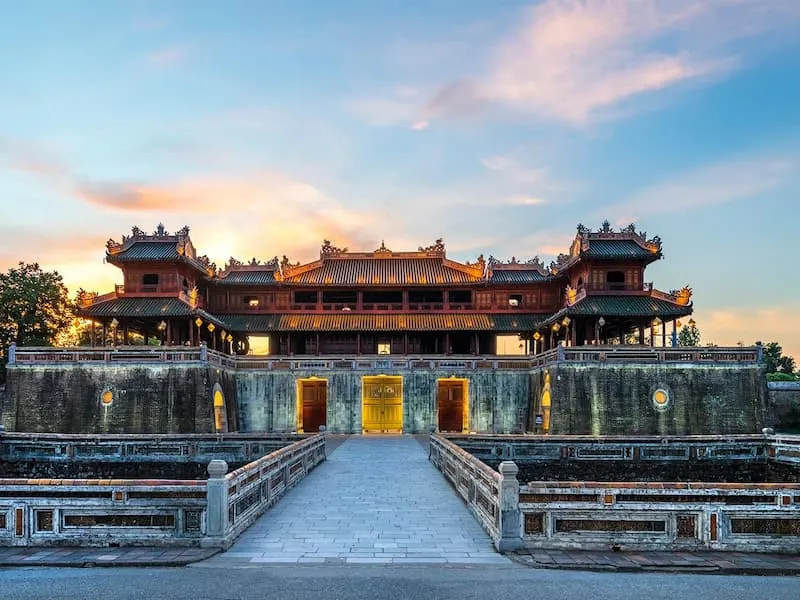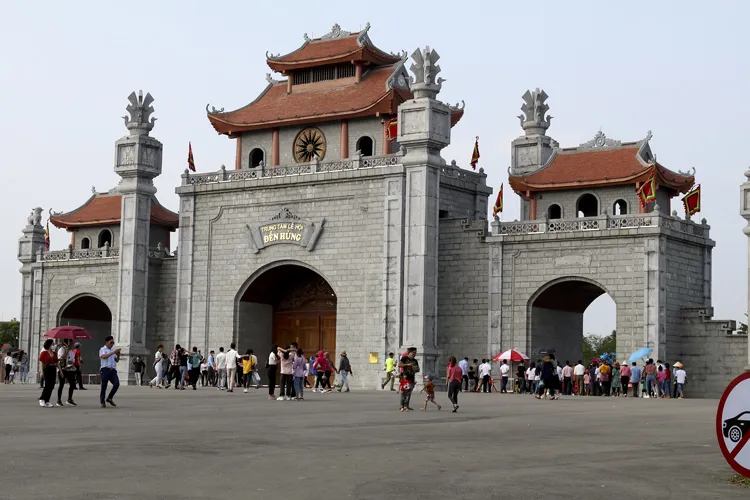Vietnam, a land shaped like the letter S, has witnessed thousands of years of nation-building and defense, leaving deep marks on its landscapes. These landmarks are not just silent witnesses of the past, but also “living museums” where every inch of soil and every brick tells heroic and poignant stories. Join “Du lịch khắp thế gian” (Travel the World) to explore these historical sites, understand our roots, and deepen your love for Vietnam.
Hue Imperial City: Witness to the Nguyen Dynasty
The Hue Imperial City, a UNESCO World Heritage Site, stands as one of Vietnam’s most significant historical symbols. Once the capital of the Nguyen Dynasty, Vietnam’s last feudal dynasty, stepping into the Imperial Citadel, the Forbidden Purple City, and the royal tombs transports visitors to another world. Here, ancient architecture intertwines with colorful tales of history and courtly culture.

Exploring Hue Imperial City is not only about admiring its unique architectural beauty but also a journey to understand a turbulent period in the nation’s history. You’ll hear stories of emperors, power struggles, and the significant contributions of the Nguyen Dynasty to Vietnamese cultural development.
Cu Chi Tunnels: Underground Warfare Marvel
The Cu Chi Tunnels, an extensive underground network stretching over 250km, exemplify the resilience and ingenuity of Vietnamese soldiers and civilians during the resistance war against America. Visiting Cu Chi allows you to witness this extraordinary construction firsthand, experience life underground, and explore hidden shelters, hospitals, and combat rooms built in secrecy and with remarkable efficiency.

Cu Chi Tunnels are not just a historical relic but also a symbol of the indomitable spirit and the desire for freedom of the Vietnamese people. This site helps us better understand the hardships and sacrifices endured by our soldiers and people during the fight for independence.
Ho Citadel: Ancient Stone Architectural Masterpiece
The Ho Citadel, located in Thanh Hoa province, is a unique architectural marvel built in the 14th century during the Ho Quy Ly dynasty. What makes the citadel special is its construction entirely from massive stone blocks, showcasing the advanced technical and artistic skills of ancient Vietnamese builders. In 2011, UNESCO recognized the Ho Citadel as a World Heritage Site, attracting visitors to explore and study Vietnamese history from this period.
The Ho Citadel is not only a unique architectural work but also evidence of power shifts and transitions in Vietnamese history. It provides insights into the role of Ho Quy Ly and his reforms for the country.
Hung Temple: The Origin of National Culture
The Hung Temple historical site in Phu Tho province is dedicated to the Hung Kings, who founded Van Lang, the first state in Vietnamese history. This is a sacred site imbued with national cultural identity. Annually, on the Hung Kings Commemoration Day (10th day of the 3rd lunar month), millions of people from across the country pilgrimage to Hung Temple to honor the Hung Kings’ contributions and pray for peace and prosperity.

Hung Temple is not just a spiritual site but also a symbol of Vietnamese solidarity and national pride. It reminds us of our origins, traditions, and the beautiful cultural values nurtured by our ancestors.
Hoi An Ancient Town: East-West Cultural Crossroads
Hoi An Ancient Town, once a bustling trading port in the 16th-17th centuries, is now a renowned tourist destination with ancient architecture and a unique cultural atmosphere. Hoi An is a melting pot of cultures, from Vietnam, China, and Japan to Western countries. This is clearly reflected in the architecture, cuisine, and customs of the local people.
Hoi An is not just an ancient town but also a living museum, preserving traditional cultural values and memories of a turbulent historical period.
Temple of Literature – Imperial Academy: Symbol of Vietnamese Education
The Temple of Literature – Imperial Academy, Vietnam’s first university, is a symbol of Vietnamese education and culture. Built in 1070 during the Ly Dynasty, it is dedicated to Confucius and other sages, and served as the venue for important national examinations.
The Temple of Literature – Imperial Academy is not only a historical relic but also a cultural center, hosting many important educational and cultural activities, contributing to the preservation and promotion of traditional cultural values of the nation.
Independence Palace: Witness to National Reunification Day
Independence Palace, also known as Reunification Palace, is a significant historical site associated with the historic event of April 30, 1975, the day of the liberation of South Vietnam and national reunification. It was once the workplace and residence of the Republic of Vietnam government.

Independence Palace is not only a unique architectural building but also a symbol of peace, unity, and independence for the Vietnamese nation.
Quang Tri Ancient Citadel: Epic of Courage and Sacrifice
Quang Tri Ancient Citadel is a historical site associated with the fierce 81-day battle in the summer of 1972. It symbolizes the heroic sacrifice and bravery of Vietnamese soldiers and civilians during the resistance war against America for national salvation.
Quang Tri Ancient Citadel is a testament to the indomitable spirit and steadfast will of the Vietnamese people in the struggle for independence and freedom.
Explore Vietnamese History Through Landmarks
Historical sites in Vietnam are not just attractive tourist destinations but also “living history books,” helping us better understand the heroic and poignant past of our nation. Take the time to explore these sites to deeply feel our roots and deepen your love for Vietnam.
Conclusion
The journey to explore Vietnamese historical landmarks is a journey back to our roots, to the beautiful cultural and spiritual values of our nation. Each landmark is a story, a lesson about history, culture, and the Vietnamese people. Let these trips become meaningful experiences, helping us to love and be proud of our country even more.